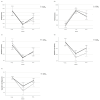A Meal with Ultra-Processed Foods Leads to a Faster Rate of Intake and to a Lesser Decrease in the Capacity to Eat When Compared to a Similar, Matched Meal Without Ultra-Processed Foods
- PMID: 39771019
- PMCID: PMC11676177
- DOI: 10.3390/nu16244398
A Meal with Ultra-Processed Foods Leads to a Faster Rate of Intake and to a Lesser Decrease in the Capacity to Eat When Compared to a Similar, Matched Meal Without Ultra-Processed Foods
Abstract
Background/Objectives: It is unknown whether the negative health effects associated with ultra-processed foods (UPFs) are due to their nutritional composition or to the extent of food processing itself. We evaluated the impact of a test meal composed only of UPF, according to the NOVA classification, compared to a similar meal without UPF in adults with obesity. Methods: This is a parallel, randomized trial. Adult individuals with obesity, according to BMI, % body fat, and/or waist circumference were included. Individuals ate one out of two test meals, matched for energy density, macronutrients, sodium, and fiber, differing in NOVA classification, as a breakfast after a 12-h fast. The rate of intake, appetite, satiety hormones, energy expenditure, and autonomic function were measured. Data were analyzed using mixed analysis of variance. Results: Forty-two individuals were included. We found a significantly faster intake rate (07:52 ± 3:00 vs. 11:07 ± 03:16 min), with less chewing and bites, and greater capacity to eat (39.68 ± 22.69 vs. 23.95 ± 18.92 mm) after the UPF meal, without observed differences in the metabolic outcomes. In an exploratory analysis, after adjusting by sex, leptin levels showed a greater decrease after the test meal in the control group. Conclusions: Although we found a faster intake rate in the UPF meal, only marginal effects were found on the participants' capacity to eat after the UPF meal. The high similarity between meals, despite differences according to the NOVA classification, may explain these results. As our study was small, these findings require further investigation.
Keywords: appetite regulation; energy metabolism; food intake; heart rate; hormones; insulin resistance.
Conflict of interest statement
The authors declare that there are no conflicts of interest.
Figures




Similar articles
-
Relation of Minimally Processed Foods and Ultra-Processed Foods with the Mediterranean Diet Score, Time-Related Meal Patterns and Waist Circumference: Results from a Cross-Sectional Study in University Students.Int J Environ Res Public Health. 2023 Feb 4;20(4):2806. doi: 10.3390/ijerph20042806. Int J Environ Res Public Health. 2023. PMID: 36833504 Free PMC article.
-
[Consumption of ultra-processed foods and relationship between nutrient intake and obesity among participants undergoing specific health checkups provided by National Health Insurance].Nihon Koshu Eisei Zasshi. 2021 Feb 26;68(2):105-117. doi: 10.11236/jph.20-044. Epub 2020 Dec 26. Nihon Koshu Eisei Zasshi. 2021. PMID: 33390509 Japanese.
-
Type and timing of ultra-processed foods consumption and its association with dietary intake and physical activity in women with obesity living in poverty.J Hum Nutr Diet. 2024 Jun;37(3):737-748. doi: 10.1111/jhn.13303. Epub 2024 Apr 1. J Hum Nutr Diet. 2024. PMID: 38558169
-
Mapping ultra-processed foods (UPFs) in India: a formative research study.BMC Public Health. 2024 Aug 14;24(1):2212. doi: 10.1186/s12889-024-19624-1. BMC Public Health. 2024. PMID: 39143524 Free PMC article. Review.
-
Beyond ultra-processed: considering the future role of food processing in human health.Proc Nutr Soc. 2023 Sep;82(3):406-418. doi: 10.1017/S0029665123003014. Epub 2023 Jun 1. Proc Nutr Soc. 2023. PMID: 37654079 Review.
Cited by
-
Association Between Psychobehavioral Factors and the Increased Eating Rate of Ultra-Processed Versus Non-Ultra-Processed Meals in Individuals with Obesity: A Secondary Analysis of a Randomized Trial.Nutrients. 2025 Jul 5;17(13):2236. doi: 10.3390/nu17132236. Nutrients. 2025. PMID: 40647340 Free PMC article. Clinical Trial.
-
Dietary Acrylamide Exposure and Its Correlation with Nutrition and Exercise Behaviours Among Turkish Adolescents.Nutrients. 2025 Aug 1;17(15):2534. doi: 10.3390/nu17152534. Nutrients. 2025. PMID: 40806118 Free PMC article.
References
-
- Monteiro C.A., Cannon G., Levy R., Moubarac J.-C., Jaime P., Martins A.P., Canella D., Louzada M., Parra D. NOVA. The Star Shines Bright. World Nutr. 2016;7:28–38.
-
- Lane M.M., Gamage E., Du S., Ashtree D.N., McGuinness A.J., Gauci S., Baker P., Lawrence M., Rebholz C.M., Srour B., et al. Ultra-Processed Food Exposure and Adverse Health Outcomes: Umbrella Review of Epidemiological Meta-Analyses. BMJ. 2024;384:e077310. doi: 10.1136/bmj-2023-077310. - DOI - PMC - PubMed
Publication types
MeSH terms
Substances
Grants and funding
LinkOut - more resources
Full Text Sources
Medical
Research Materials

